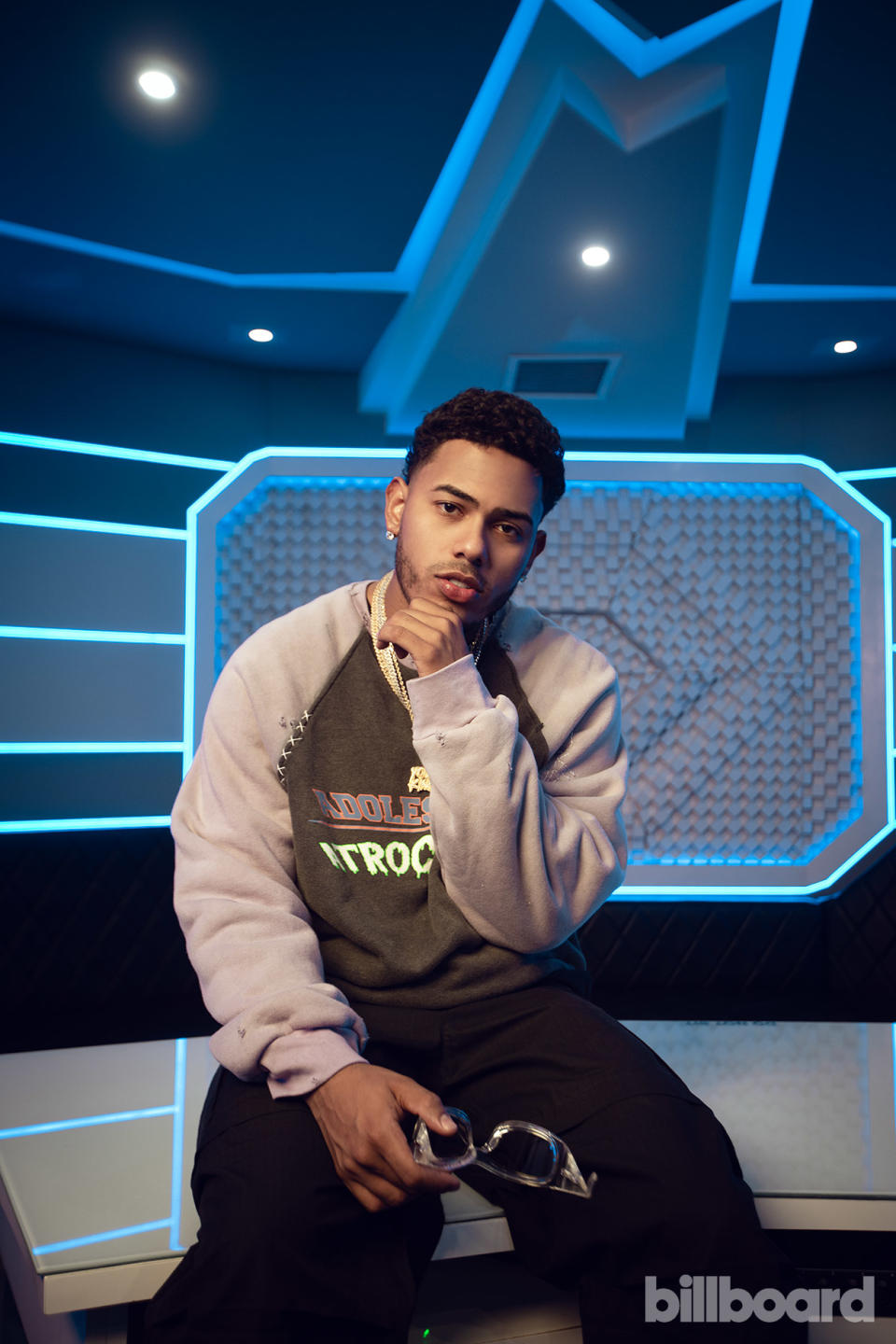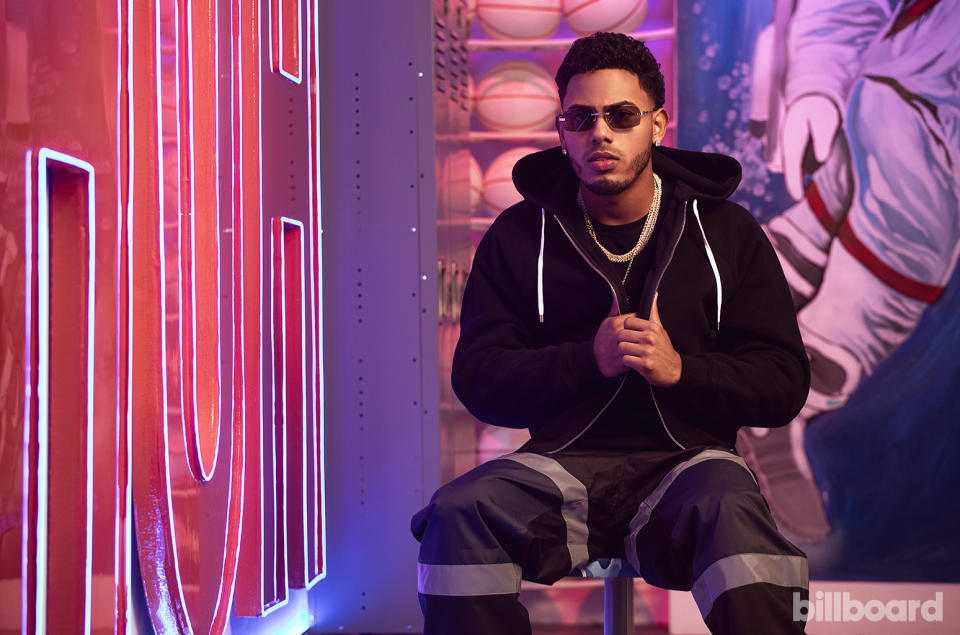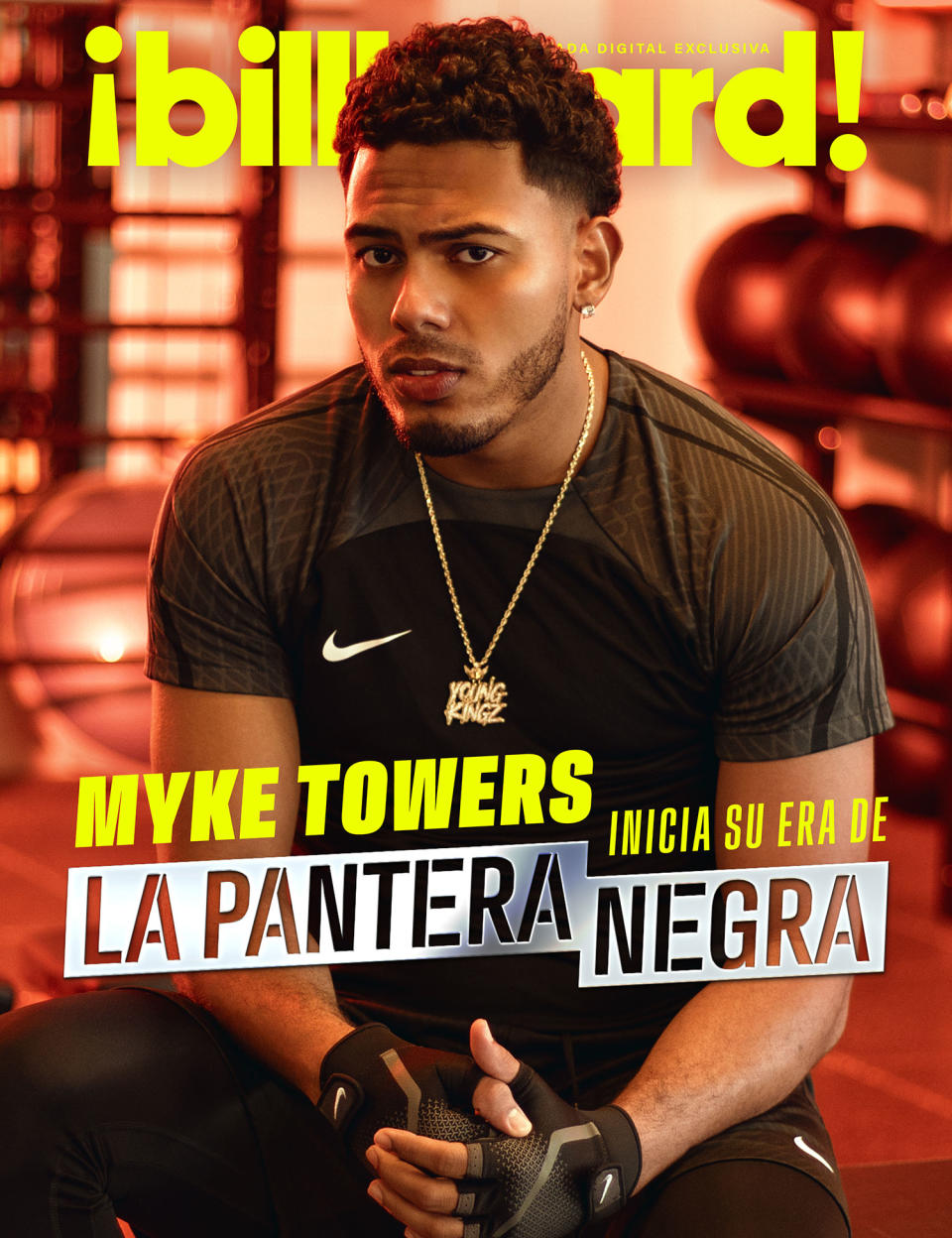Myke Towers Goes Into ‘Black Panther’ Mode
- Oops!Something went wrong.Please try again later.
- Oops!Something went wrong.Please try again later.

Myke Towers was just a child when he saw the future. On his way to school in Río Piedras, Puerto Rico, he had his first real-life glimpse of Tego Calderón, the Black rapper who at the time was one of the island’s — and Latin music’s — biggest stars.
“I was a little kid with a backpack, and he was in a huge Cadillac,” Towers recalls. “When you see that in real life, you don’t forget. Tego saw just another kid. But for me — on my way to school — that was a Kodak moment. You get it? It was, ‘Wow, if Tego did it, how can I do it my way?’ ”
More from Billboard
UMG's Regional Mexican Label Fonovisa-Disa Appoints Ana Martinez as U.S. GM
La era de 'La Pantera Negra': Myke Towers encuentra su poder
That chance encounter set in motion the way Towers saw himself: as a Puerto Rican act whose core is rap but who also sings reggaetón; who collaborates prolifically but releases mostly solo albums; who is notoriously private but identifies strongly as a Black artist. And now, following the huge success of his 2023 hit “Lala,” and with the backing of Warner Music, as a Latin urban artist who is willing to experiment to gain global success.
On April 25, Towers released “Adivino,” the focus track from his upcoming album, La Pantera Negra, due out likely at the end of May. Featuring Bad Bunny, “Adivino” is dance banger with a subtle reggaetón beat built over padded synths; it’s ear candy with pop leanings, as “Lala” was, but it’s also romantic and wistful and unexpected in its downtempo breaks.
It’s an auspicious kickoff for La Pantera Negra (The Black Panther) — an album Towers says goes back “to what I like to do musically, and to what people liked about my essence from the beginning, when they got to know me and said, ‘This kid has the goods.’ ”
Its single notwithstanding, La Pantera Negra is mostly a solo effort, and “a priority for the entire company,” says Warner Music Latin America president Alejandro Duque, who has plans to support the album beyond traditional Latin music markets and into places like Europe, where Towers is touring this summer.
“Latin music’s influence and global impact are undeniable. But Myke’s versatile flow and magnetic presence go beyond the confines of any single language or culture,” adds Max Lousada, CEO of recorded music for Warner Music Group, who was heavily involved in signing Towers to a global distribution deal with Warner Music Latina and Warner Records in 2021. “He effortlessly experiments with new sounds and pushes the boundaries of artistic expression. We’re proud to support Myke’s journey as he continues to make his mark with original music that is exciting fans around the world.”
La Pantera Negra is the follow-up to 2023’s La Vida Es Una, which in turn spawned global hit “Lala,” a chill, downtempo dance track with a reggaetón beat that was a departure from Towers’ more urban fare. Given the extraordinary success of “Lala” — it hit No. 1 on the Billboard Global Excl. U.S. chart — Towers’ 1.8 billion on demand streams in the United States alone, according to Luminate, and his more than 44 million Spotify listeners (making him No. 61 on the platform), expectations are high for the set.
But Towers is looking straight ahead.
“Obviously, I know there’s [a lot going on], but I try to make it just another day at the office,” he says. “Because that’s how I did these songs. Another day at the office. I’m not looking for the hit, nor losing my focus. I always try to stay on the same wavelength.”

Towers is chatting and playing new music inside a black SUV that’s driving slowly through Miami’s Design District on a Thursday night. It’s 10 p.m., shops are shuttered, and there are few people out. But Towers, notoriously private, wanted a private space, and this is it. Still, there’s a cluster of people inside: his driver and trainer in the front seat, his publicist and security in the back, and Towers and myself in the middle.
Like so many Puerto Rican urban artists, Towers — who tonight is dressed in a light blue track suit — likes traveling in packs. But unlike many, he can truly compartmentalize and command those around him. Later, he will tell me that when he’s working in the studio, “Everyone has to behave like we’re on a spaceship; focused on the project at hand, no distractions.”
Which explains why tonight it’s quiet inside the SUV as he pulls out a good bottle of Caymus Cabernet (“I heard you like wine,” he says) from his backpack, pours it into small plastic wine glasses he shares with his publicist and I before playing a few tracks from La Pantera Negra.
Aside from Towers’ collaboration with Bunny, their first since “Puesto Pa’ Guerrial” in 2020, there’s a collab with Peso Pluma, “who I really like how he understands reggaetón,” Towers says. “Obviously it’s a Mexican representation, but reggaetón style, which he does well.”
Other new names in the mix include Benny Blanco, who produced one of the strongest tracks on the set, a remix of a classic 1990s American pop/folk track that speaks to Towers’ respect for the past; every one of his albums includes a look back.
But overwhelmingly, La Pantera Negra is a return to Towers’ origins, literally, musically and figuratively.
“There was a legendary person in my neighborhood [Quintana, in Río Piedras] who had several panthers as pets. One escaped and it was a mess. So I said, ‘I’m from here. I’m the black panther of Quintana,’ ” Towers recalls.
But it’s also impossible to ignore the symbolism of the “Black Panther” moniker and all it conveys, which is why Towers waited to use the name at a time when he truly embodied it.
“It’s something I’ve been called before, but I had to believe it. When you’re the protagonist of something, you don’t really see what’s going on until others do. That happened to me.”
La Pantera Negra, the album, kicks off with the eponymous track that describes where Towers is now and how he feels: powerful. “I feel we’re in a good moment, we have staying power. I can give people something they’re not used to, but it also helps me because when I go back to my essence, you feel the contrast.”
And after “Lala,” which was a musical departure for Towers, “La Pantera Negra goes back to my essence.”

But what exactly is Towers’ essence? Musically, it’s clear. He navigates between reggaetón and rap — although he clearly prefers the latter — with clear influences from Puerto Rican hip-hop pioneers like Daddy Yankee and Calderón as well as commercially successful rappers like Jay-Z and Drake, with his albums alternately focusing more on one style than the other.
From a personal standpoint, Towers is more enigmatic. Tall and lanky — his muscles defined thanks to a yearlong new workout regime — he comes across as reserved and polite, using a self-effacing brilliant smile as a shield, but still conveying the assuredness of someone who has done a lot of self-reflection.
Unlike many of his counterparts — who post constantly on Instagram and TikTok about their personal lives, prowess and riches (the plane, the watch, the car) — Towers is famously private. His Instagram account, where he has 12.1 million followers, is devoid of personal content, save for the occasional workout photo, and he rarely and reluctantly speaks about childhood sweetheart Ashley Gonzalez, the mother of his son, Shawn Lucas. Now 4 years old, Shawn (named after Shawn “Jay-Z” Carter), who Towers holds as a baby on the cover of his 2020 album, Easy Money Baby, made a rare appearance onstage at his father’s show at Miami’s Kaseya Center last fall. Beyond that, questions in that area are politely deflected.
“Just say he’s growing quickly,” Towers finally musters, looking away with that smile. “That’s separate from what I do,” he adds. “That’s my life. I have my social media because it’s a tool. But otherwise, I want people to listen to my music and just imagine what I’m like.”
Michael Anthony Torres Monge is now 30 years old, no longer the baby-faced rapper who dazzled in 2018 and 2019 with a seemingly never-ending string of hits featuring a rotating cast of collaborators that was a who’s who of reggaetón.
It was all a prelude to his second album, Easy Money Baby — which included only solo tracks save for a single collaboration with Farruko. Released on Puerto Rican indie Whiteworld Music, it debuted at No. 1 on Billboard’s Top Latin Albums chart in February 2020 and established a blueprint for Towers’ future output: His singles would be collabs from all sides of the music spectrum — they’ve ranged from Becky G and Sebastián Yatra to Jay Wheeler and Quevedo — but his albums would largely be solo efforts.
Exactly a year later, Towers and Whiteworld signed their global distribution deal with Warner Records and Warner Latina that was brokered between Warner’s Latin department along with Lousada and Warner Records co-chairmen Aaron Bay-Schuck and Tom Corson, with the latter calling it at the time “one of our most important signings of the past year.”
Today, the Warner pact, a distribution deal with full services, has been extended, but Towers’ masters still belong to him and his original co-managers, Orlando “Jova” Cepeda and José “Tito” Reyes, co-owners of Whiteworld. The two signed Towers in 2018, buying his contract from another independent label.
“He was like an ugly duckling, vastly underestimated; quiet, humble, the opposite of the genre. But we saw the originality in him. His voice was different from anybody else’s,” Cepeda told Billboard at the time. He adds today: “I told him he was a star.”

Towers, born in Río Piedras, the cradle of reggaetón, fell in love with making music thanks to his grandmother, who owned a karaoke machine and was constantly practicing in her little home studio.
“I think that’s where I learned to write songs,” says Towers, who to this day writes most of his songs in notebooks that he never tosses out.
“The notebook is always with me, in my backpack. I also write on my phone, but anytime I want to develop something, I pick up my notebook. I have 10 years’ worth of notebooks in bags around the house. One of these days, I want people to study them and see what I did in real time and say, ‘Damn, that’s how he wrote this song.’”
The weight of history has always mattered to Towers, and although he doesn’t constantly reference his Black experience in his songs, he speaks of it often and is aware of the responsibility.
“People know I’m Black. Everyone says, “‘El negro llegó y rompió’ [“The Black kid came and hit it”],” he says. “We represent both the culture and the world at the same time. It’s not a division, but I have to represent my own.”
Disciplined in the recording studio and in public, Towers is prolific, consistent and a meticulous songwriter, all traits that have allowed him to stand out and remain relevant in the very crowded field of Puerto Rican urban acts that rose to prominence in the mid-2010s.
“The way this guy puts a song together is so next level,” says Blanco, who first met and worked with Towers this year. “You blink an eye, and he already has the full song written and recorded. It’s truly spectacular to watch.”
The connection with Blanco was made by Brandon Silverstein, founder and CEO of S10 Entertainment (who previously managed Anitta), who came in to co-manage Towers with Cepeda last year, specifically to help in the Anglo space.
Soon after Silverstein came in, “Lala” exploded.
By then, Towers had numerous hits on the Billboard charts; he has 51 career entries on Hot Latin Songs, with 10 top 10s, and 11 No. 1s on Latin Airplay, for example. With La Vida Es Una, he captured his third straight top 10 on the Top Latin Albums chart when the set debuted at No. 9 in April 2023. Then, unexpectedly, “Lala,” track No. 22 out of 23 on the album, began to rise.
“‘Lala’ is that stroke of luck you don’t expect. I knew many artists have that moment in their careers, but it hadn’t come for me,” Towers says. In fact, “Lala” wasn’t even going to appear on the album. The track, which Towers originally began working on two years prior, had been made in bits and pieces, and at one point, wasn’t even slotted to be on the album.
“Finally, they convinced me to include it. I can’t say I realized how big it was. Many times, you get carried by your instinct, but in this case, my instinct didn’t speak to me.”
But everything else did.
While “Lala” was not the album’s focus track, almost immediately, “It began to trend,” Duque says, particularly on TikTok. “With a hit, reaction can vary, but with ‘Lala,’ every little thing we did got huge jumps. So, we went full throttle,” he says.
“Lala” climbed steadily, and by July, it hit No. 1 on the Billboard Global Excl. U.S. chart and No. 3 on the Billboard Global 200, both milestones for Towers.
Cepeda firmly believes that releasing “lots of music” is essential to Towers’ success: “Artists lose steam because they don’t release new music [for their fans],” he says, then quips, “If you don’t take care of your wife at home, someone else will.”
And so, before the year was out, Towers released a second studio album, LVEU: Vive la tuya…No La Mía, a sort of part two to La Vida Es Una that included another mega-hit, “La Falda,” which topped the Latin Airplay chart.
Then, Towers reset. After playing his last concert of the year, he disconnected completely from his music and spent over a month between Puerto Rico and the Dominican Republic with his family and his “friends who are like family to me, who are next to me even if I’m not doing music, who don’t even want to take photos with me because I’m one of them,” he says. “That’s what keeps me grounded. And I’ve also learned to be alone, too, to connect with oneself and with your essence, and then come back. I have my breaks where I plant, and my breaks where I harvest.”
These are the periods Towers describes as “out of the music scene. When I take off my superhero cape.”
Now, he’s coming back as a superhero, almost literally.
“I even studied how panthers attack,” Towers says. “I had been toying with the panther concept for a while, but now we started the year like this and everything we do will be under that roof.”
Towers will be playing the festival circuit this summer in Europe but will start with his first sold-out date at Madrid’s Wiznik Center on May 21. By then, La Pantera Negra will be in full swing after the release of “Adivino.”
“We’ll be working every single separately, of course, but with the storyline of the album and black panther,” Duque says, noting that Towers is enormously popular in Spain, Italy and Portugal. “It’s a very broad album. Myke is not only an urban artist, and our goal is to grow his audience to the max.”

Best of Billboard
H.E.R. & Chris Brown 'Come Through' to No. 1 on Adult R&B Airplay Chart
Anne Wilson's 'I Still Believe in Christmas' Crowns Christian Airplay Chart

